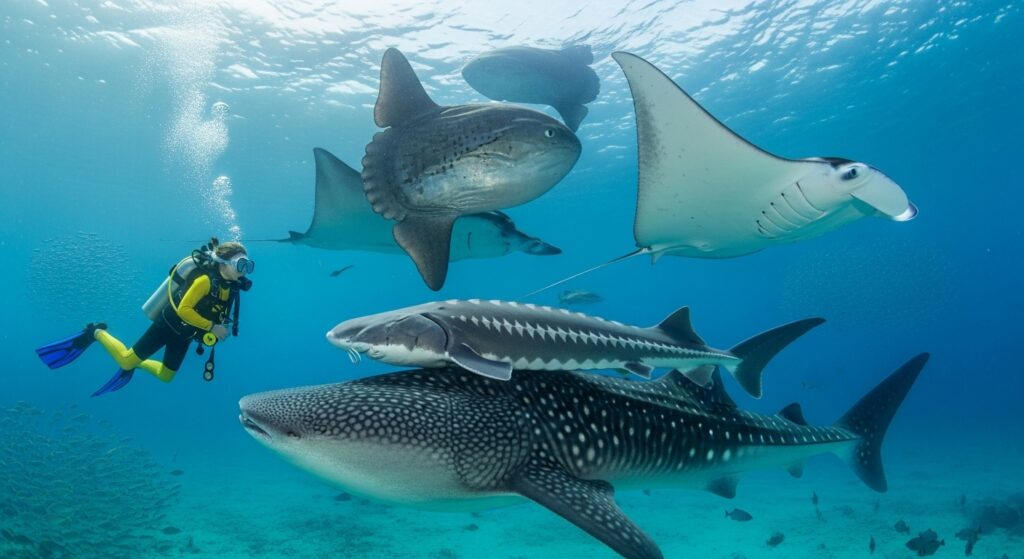Fish have fascinated humans for centuries, not just for their beauty but also for their incredible variety in size. Some species stretch longer than a school bus, while others are so heavy they outweigh small cars. These giants dominate oceans, rivers, and lakes with sheer presence.
Understanding the largest and tallest fish helps us see how ecosystems remain balanced. From plankton feeders to apex predators, their presence ensures food chains remain stable. Studying these giants also helps conservationists protect vulnerable marine species for future generations.
What Makes a Fish the Largest or Tallest?
When talking about the largest fish, two aspects often come into focus: length and weight. Some species may not be the heaviest but stretch to impressive lengths, while others weigh thousands of pounds, making them giants of the sea. Size can be influenced by evolutionary adaptation, availability of food, and the environment they thrive.
Scientists usually measure fish size by standard length, total length, and maximum recorded weight. Each record highlights the exceptional diversity that exists in aquatic environments. For fans who enjoy comparing themselves with marine giants, some online tools like Easy Height Compression now display height differences using a 3D chart, making it easier to visualize how truly massive these fish are with humans.
What are the Largest and Tallest Fish Species
The aquatic world holds remarkable giants that are unmatched in size and scale. Here are the ten largest and tallest fish species on Earth, each with unique traits that highlight the diversity of our planet’s waters.
1. Whale Shark
The whale shark is the biggest fish in the world, growing up to 40 feet long and weighing more than 20 tons. They live in warm tropical oceans, often near Mexico, the Philippines, and Australia. Despite their size, they only eat plankton, krill, and small fish, filtering them through their wide mouths. Their species is believed to be over 60 million years old, making them true ocean giants that have swum the seas since the time of dinosaurs.
2. Basking Shark
The basking shark is the second-largest fish, reaching up to 33 feet in length and weighing around 5 tons. They are often found near the coasts of the UK, Ireland, and Canada, where waters are rich in plankton. Like whale sharks, they open their mouths wide to filter tiny food from the sea. Fossil records suggest basking sharks have existed for at least 30 million years, making them ancient and peaceful plankton eaters.
3. Great White Shark
The great white shark can grow more than 21 feet long and weigh over 5,000 pounds. They live near coasts in South Africa, California, and Australia. Unlike the gentle plankton feeders, great whites eat seals, sea lions, tuna, and sometimes dolphins. Their species dates back 11 million years, and they can live up to 70 years. With their strong bodies and hunting skills, they are the ocean’s most famous predators.
4. Tiger Shark
Tiger sharks reach lengths of 16 to 18 feet and weigh about 1,400 pounds. They are found in tropical waters around Hawaii, the Caribbean, and the Pacific Islands. Their diet includes fish, sea turtles, birds, and even garbage, which is why they’re nicknamed the “garbage cans of the sea.” Their species is believed to be around 23 million years old, and they can live up to 30 years.
5. Giant Oceanic Manta Ray
The giant oceanic manta ray has a wingspan that can stretch more than 29 feet across, making it appear to be flying underwater. These rays live in tropical waters near Mozambique, the Maldives, and Indonesia. They eat plankton and small fish, doing flips and rolls while feeding. Fossil evidence indicates that manta rays have been present for approximately 20 million years, and they can live up to 50 years.
6. Beluga Sturgeon
The beluga sturgeon is a river giant that grows up to 24 feet long and weighs over 3,000 pounds. Found in the Caspian and Black Seas near Russia, Iran, and Kazakhstan, they are famous for producing caviar. They eat small fish and invertebrates. Sturgeons are some of the oldest fish alive, with their species tracing back 200 million years, making them true “living fossils.”
7. Ocean Sunfish (Mola mola)
The ocean sunfish is the heaviest bony fish, weighing up to 5,000 pounds and measuring 10 feet across. They live in temperate and tropical oceans near Portugal, Japan, and California. Their main food is jellyfish, though they also snack on squid and small fish. Scientists believe sunfish have been around for 45 million years, and they usually live 10 to 20 years.
8. Greenland Shark
The Greenland shark grows up to 21 feet long and weighs about 2,200 pounds. They live in the icy waters of the North Atlantic near Greenland, Iceland, and Canada. They eat fish, seals, and even scavenged remains. Known as the longest-living vertebrate, Greenland sharks can live for 400 years, with their species dating back over 100 million years.
9. Giant Trevally
The giant trevally may not be as big as sharks, but at 6 feet long and 180 pounds, it’s a strong and fast predator. Found in tropical waters around Hawaii, East Africa, and Australia, it hunts fish, crustaceans, and even small birds. Fossil evidence shows trevallies have been around for about 2 million years, and they live up to 25 years.
10. Manta Ray Relatives (Reef Manta Ray)
Reef manta rays can reach a wingspan of 15 feet and weigh about 3,000 pounds. They are often found in warm waters near the Maldives, Fiji, and Thailand, gliding gracefully near coral reefs. Their diet is mostly plankton and small shrimp-like creatures. This species has existed for millions of years, and they typically live around 40 years.
FAQs
What is the biggest fish in the world?
The whale shark holds the title as the largest fish, reaching up to 40 feet in length and weighing more than 20 tons.
Which fish has the widest wingspan?
The giant oceanic manta ray has the largest wingspan, stretching beyond 29 feet across.
Are all large fish dangerous?
Not at all. Many large species, like whale sharks, basking sharks, and manta rays, are gentle filter feeders that pose no threat to humans.
Conclusion
The largest and tallest fish species remind us of the ocean’s incredible diversity. From the gentle whale shark to the powerful great white, these giants shape marine ecosystems and inspire awe. Protecting them ensures biodiversity and the health of global waters for future generations.





